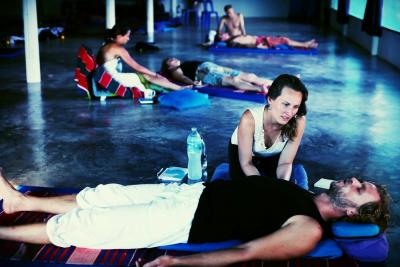

by Alanna Ketler, Collective Evolution
Holotropic breathing is a powerful tool that can be used to unlock other states of consciousness, work through past traumas, heal anxiety and depression, gain wisdom, and so much more. There are many who believe that this is the only way to reach these realms of consciousness without taking psychedelic substances such as psilocybin, DMT, ayahuasca, and the like.
History of Holotropic Breathwork
The scientific method and alternative medicine aspect of Holotropic Breathwork was first discovered by Stanislov and Cristina Grof during the 1970s and 1980s. They both studied medicine and psychoanalysis at the Charles University School of Medicine in Prague, Czech Republic. From past experiences, they knew that the most powerful way to induce these higher levels of consciousness was through the use of psychedelic substances; however, there are some potential drawbacks and concerns that come along with the use of such substances. The Grofs then developed a safe and effective way to achieve comparable states of consciousness, using one’s breath alone.
In 1980, Christina Grof founded the Spiritual Emergence Network (SEN) to spread the wisdom she had gained and help the many individuals who, like herself, had been struggling with their own emotional conflicts. Stan and Christina travelled all over the word to spread what they had learned in regards to Holotropic Breathwork and Transpersonal Psychology.
What Does It Involve?
The process of Holotropic Breathwork is usually conducted in a workshop or class setting, though many instructors will also offer private sessions as well. Generally each person is paired with a partner; one is the ‘breather’ and one is the ‘sitter.’ The sitter is there to provide tissues and assistance to the bathroom, and to hold space for the breather, as this tends to be an intensely emotional process. The sitter is there to be a caring, supportive, fully present person to provide the breather with the feeling and comfort of being in a safe and loving environment.
The breather lies down on a mat and covers up with blankets, then the breathwork facilitator will lead a simple relaxation exercise to begin. Then, the instructor will turn on some music and the breathwork begins. The breather then will begin to breathe faster and deeper, as facilitated by the instructor. Many suggest using a circular breath technique, which means no pauses between the in and out breath, so it is a pretty quick, non-stop breath. The breathing becomes deeper and more rapid as time progresses. This can be somewhat challenging to maintain, so often the sitter will remind the breather to keep breathing faster and deeper.
After about two hours, the breathwork part of the session comes to a close. Afterwards, some instructors encourage the participants to draw a mandala to describe their experience, and then everyone gets a chance to share what came up in a loving, supportive, non-judgmental environment.
What Can the ‘Breather’ Expect?
There is an extremely wide range of possible experiences one can have using this method of breathwork. This range can include deep feelings of joy or serenity, deep meditative states, re-experience of traumatic births (often people will feel pressure around their temples, which is believed to be from those babies born with the aid of forceps), tension, pain, warmth, cold, crying hysterically, body convulsions, numb or tingly hands, and many, many more. For me personally, I experienced deep relaxation one time, and another a sense of tremendous pride in myself for everything I had been able to overcome, which brought me to tears.
The non-ordinary states that the breathwork induces can be categorized as:
1. Sensory
2. Biographical
3. Perinatal (Birth Process)
4. Transpersonal (beyond the body and personal identity)
It is important to not try to direct the experience in any particular way, but rather let it guide you where it wants to go. Whatever comes up is coming up for a reason, and the unconscious mind will take you wherever you need to go heal, release, and transform.
Who Shouldn’t Participate in Holotropic Breathwork?
Breathwork is contraindicated in any of the following cases: cardiovascular problems, glaucoma, pregnancy, recent surgery, epilepsy (some cases are okay if approved by healthcare practitioner), asthma, some mental illnesses, and those struggling with addiction.
How Can You Attend a Holotropic Breathwork Session?
If this seems like something you would like to try for yourself to work through any blockages, past traumas, or other issues, just try searching for Holotropic Breathwork (Your City) in Google and see what comes up. This method of healing is becoming increasingly popular and easier to find, as people have been continuing to experience tremendous, sometimes life-changing, benefits from these sessions.
How incredible is it that we can utilize modalities such as this — no substance required except for our own breath — to achieve and unlock higher states of consciousness and let go of what may be holding us back in life? Simply amazing.
Much Love


Comments
This is Very Interesting + Useful
Sounds like this could be Very Helpful.
Thanks for Posting.